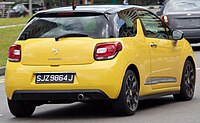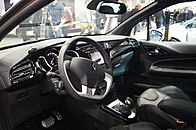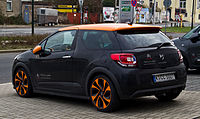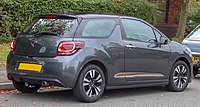Citroën_DS_Inside
DS 3
Motor vehicle
The DS 3 (formerly known as Citroën DS3 and DS 3 Crossback) is a luxury supermini initially produced by the French automobile manufacturer Citroën and officially launched in January 2010.[1] Positioned below the DS 4, this was the first and entry-level model from the DS premium sub-brand (pronounced déesse, which is French for goddess), which was spun-off in 2016 into DS Automobiles.[2]
| DS 3 | |
|---|---|
DS 3 Crossback (pre-facelift) | |
| Overview | |
| Manufacturer |
|
| Also called |
|
| Production | 2009–present |
| Body and chassis | |
| Class |
|
| Body style |
|
| Layout | Front-engine, front-wheel-drive / all-wheel-drive |
Originally manufactured as a three-door supermini hatchback with a convertible variation from 2009 to 2019, the second generation became a five-door Crossover SUV, named as DS 3 Crossback from 2018 to 2022.
The model was named "2010 Car of the Year" by Top Gear, awarded first supermini four times in a row by the JD Power Satisfaction Survey UK[3][4][5] and second most efficient supermini (Citroën DS3 1.6 e-HDi 115 Airdream: 63.0 mpg‑imp (4.48 L/100 km)) by What Car? behind the Citroën C3.[6] In 2013, it was again the most sold premium subcompact car with 40% of these market shares in Europe.[citation needed]
| First generation | |
|---|---|
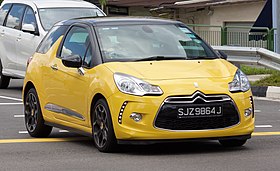 DS 3 (pre-facelift) | |
| Overview | |
| Manufacturer |
|
| Also called | Citroën DS3 (2009–2016) |
| Production | 2009–2019 |
| Assembly | France: Poissy (PSA Poissy Plant) Malaysia: Gurun (NAM) |
| Designer | Frédéric Soubirou (exterior)[7] |
| Body and chassis | |
| Class | Supermini (B) |
| Body style | 3-door hatchback 3-door convertible |
| Layout | Front-engine, front-wheel-drive / all-wheel-drive |
| Platform | PSA PF1 platform |
| Related | Citroën C3 Citroën C4 Cactus Peugeot 208 |
| Powertrain | |
| Engine | |
| Transmission | 5-speed manual 6-speed manual 4-speed automatic 6-speed automatic |
| Dimensions | |
| Wheelbase | 2,464 mm (97.0 in) |
| Length | 3,948 mm (155.4 in) |
| Width | 1,715 mm (67.5 in) |
| Height | 1,458 mm (57.4 in) |
| Curb weight | 974–1,175 kg (2,147–2,590 lb) |
| Chronology | |
| Predecessor | Citroën C2 Citroën C3 Pluriel (for DS3 Cabrio) |

The vehicle was initially intended to be sold as a 3-door second-generation Citroën C3. 2007 advanced projects are showing the vehicle sharing an identical front with the production second-generation C3 and no mention to the DS sub-brand. At this stage, the vehicle was named Citroën C3 Coupé.[8]
The original Citroën DS3 design was first introduced as a concept car named Citroën DS Inside, unveiled on February 5, 2009, at the Geneva Motor Show,[9] introducing both the 2009 Citroën logo redesign and their DS sub-brand. The production model, called Citroën DS3, was introduced in August 2009, two months after the Citroën C3 II, with no emphasis that the two cars were having a lot in common.
Citroën revamped their DS3 line for the summer of 2011 with a new, limited edition model, a new colour and a new decal on the roof. The new colour is brun Hickory, a shade of dark brown that recently made its debut on the DS3's bigger sibling, the DS4. One of the DS3's strongest selling points is the ability for a customer to personalize their car when they order it by mixing and matching body and roof colours, decals, and so on. This new colour helps that by bringing the total amount of available body colours to ten.
The DS3 features prominently in the video for the Pixie Lott song "What Do You Take Me For". It is the first car that has had product placement in a British music video.[10]
The DS3 range received a mild facelift in 2014, with revised engines and new design of Xenon-LED headlights for the top of the range models.[11] The new BlueHDi diesel, available in two states of tune, has a low CO2 emissions level of 79g/km. It received a new facelift in 2016, completely dropping any reference to Citroën and its logo.
- DS 3 (pre-facelift; rear view)
- Interior
DS3 Racing
A 207 hp (154 kW) version,[12] the DS3 Racing, was introduced at the 2010 Geneva Motor Show. It is the road version of Citroën's rally specification car DS3 R3. The new 0-62 mph time is 6.5 seconds and the increased top speed is 146 mph (235 km/h).
The DS3 Racing was offered in only two colours, white with grey accents or black with orange accents including roof, wheels and interior. Besides these unique colour schemes, the DS3 Racing is distinguished from other trim levels by the use of real carbon fibre on the front splitter, grill, wheel arches and rear diffuser. Additionally, carbon fibre is prominently featured on the interior.[13]
In October 2011, Citroën announced that they were planning on building a total of 2,400 DS3 Racings, significantly more than the 1,000 initially planned in 2010.[14]
The Citroën DS3 WRC was used by the Citroën World Rally Team in WRC competitions between 2011 and 2016.
- Citroën DS3 Racing (front view)
- Citroën DS3 Racing (rear view)
DS3 Cabrio

Citroën unveiled the DS3 Cabrio at the Paris Motor Show in September 2012, with sales commencing in 2013.[15]
As a fixed profile convertible, the DS 3 retains its side bodywork, allowing for a roll back center fabric sunroof – similar to other fixed profile convertibles including the Fiat 500 (2007), Nissan Figaro (1991), Citroën 2CV (1948–1990) and the Nash Rambler Convertible "Landau" Coupe (1950).
Matière Grise edition
Citroën announced the "Matière Grise" limited edition of 750 cars for the European market. It is finished in flat grey paint with chromed mirrors, chromed door trim and chromed tail light surrounds. The roof can be ordered in either white or black and the only available wheels are 17″ alloys, also available in white and black.[16]
Facelift
In February 2016, the facelifted DS 3 was announced by DS Automobiles, as part of their separation from Citroën to become a standalone brand. The new DS 3 was launched at that year's Geneva Motor Show. The revised model no longer featured Citroën badges,[17] with the DS badge now featuring prominently on the front grille. The trim level names were also changed from DSign, DStyle and DSport and re introduced as Chic, Elegance and Prestige. An Ultra Prestige model was also added.
The facelifted model is identified by a revised front and rear design, plus the new range of PSA engines incorporating the 1.2-litre three cylinder PureTech petrol engines (available in normally aspirated 82 bhp and turbocharged 110 and 130 bhp variants), the 1.6-litre THP turbocharged petrol engine with 165 bhp, and 1.6-litre BlueHDi turbo diesel engines with 100 and 120 bhp. In addition, a new DS 3 Performance model was introduced with the THP engine uprated to 210 bhp, with a 0–100 km/h time of 6.5 seconds.
In June 2016, DS partnered with French luxury fashion and perfume company Givenchy and launched the DS 3 Givenchy Le MakeUp special edition.[18] A total of 500 Givenchy models were built and include unique features such as a textured matt white body with metallic purple roof and door mirrors, a rose pink dashboard strip and a make-up storage kit in the front central armrest. It is available with the PureTech 110 engine in manual or automatic transmission, and is based on the mid range Elegance trim level.
The DS Performance Line was launched in September 2016,[19] enabling the DS customer to have performance styling without any mechanical upgrades. DS 3 Performance Line includes aesthetics such as gloss black alloy wheels, black contrasting roof colour, exterior stripe graphics and interior coloured stitching.
- Front view
- Rear view
Specifications
| Model | Year | Engine | Power | Torque | 0–100 km/h (0–62 mph) |
Top speed | Transmission | CO2 emission (g/km) |
|---|---|---|---|---|---|---|---|---|
| VTi 82 | 2012–present | 1199 cc I3 | 82 PS (60 kW; 81 hp) at 5,750 rpm | 118 N⋅m (87 lbf⋅ft) at 2,750 rpm | 14.2 s | 174 km/h (108 mph) | 5-speed manual | 104 |
| VTi 95 | 2009–2012 | 1397 cc I4 | 95 PS (70 kW; 94 hp) at 6,000 rpm | 135 N⋅m (100 lbf⋅ft) at 4,000 rpm | 10.6 s | 183 km/h (114 mph) | 134-136 | |
| PureTech 110 | 2015–present | 1199 cc I3 | 110 PS (81 kW; 108 hp) at 5,500 rpm | 205 N⋅m (151 lbf⋅ft) at 1,500 rpm | 9.6 s | 190 km/h (118 mph) | 104 | |
| 9.9 s | 188 km/h (117 mph) | 6-speed automatic | 108 | |||||
| PureTech 130 | 2016–present | 1199 cc I3 | 130 PS (96 kW; 128 hp) at 5,500 rpm | 230 N⋅m (170 lbf⋅ft) at 1,750 rpm | 8.9 s | 204 km/h (127 mph) | 6-speed manual | 105 |
| VTi 120 | 2009–2015 | 1598 cc I4 | 120 PS (88 kW; 118 hp) at 6,000 rpm | 160 N⋅m (118 lb⋅ft) at 4,200 rpm | 8.9 s | 190 km/h (118 mph) | 5-speed manual | 136-138 |
| 10.9 s | 4-speed automatic | 153-155 | ||||||
| THP 150[22] | Unknown | 1598 cc turbo I4 | 156 PS (115 kW; 154 hp) at 6,000 rpm | 240 N⋅m (177 lb⋅ft) at 1,400-4,000 rpm | 7.3 s | 214 km/h (133 mph) | 6-speed manual | 155 |
| THP 155 | 2010–present | 139 | ||||||
| THP 207 | 2010–2015 | 207 PS (152 kW; 204 hp) at 6,000 rpm | 275 N⋅m (203 lb⋅ft) at 2,000 rpm | 6.5 s | 235 km/h (146 mph) | 149 | ||
| THP 210 | 2016–present | 1598 cc turbo I4 | 210 PS (154 kW; 207 hp) at 6,000 rpm | 300 N⋅m (221 lb⋅ft) at 3,000 rpm | 6.5 s | 230 km/h (143 mph) | 6-speed manual | 125 |
| Model | Year | Engine | Power | Torque | 0–100 km/h (0–62 mph) |
Top speed | Transmission | CO2 emission (g/km) |
|---|---|---|---|---|---|---|---|---|
| HDi 90 FAP | 2009–present | 1560 cc turbo I4 | 90 PS (66 kW; 89 hp) at 3,750 rpm | 230 N⋅m (170 lb⋅ft) at 2,000 rpm | 11.3 s/11.5 s | 180 km/h (112 mph) | 5-speed manual | 104/99 |
| HDi 110 FAP | 2009–present | 110 PS (81 kW; 108 hp) at 4,000 rpm | 270 N⋅m (199 lb⋅ft) at 2,000 rpm | 9.8 s | 118 mph (190 km/h) | 6-speed manual | 115 | |
| e-HDi 90 Airdream manual 95g | 2010?–present | 91 PS (67 kW; 90 hp) at 4,000 rpm | 230 N⋅m (170 lb⋅ft) at 1,750 rpm | 12.5 s | 182 km/h (113 mph) | 5-speed manual | 95 | |
| e-HDi 90 Airdream manual 99g | 2010–present | 98 | ||||||
| e-HDi 110 Airdream | 2011–present | 112 PS (82 kW; 110 hp) at 3,600 rpm | 270 N⋅m (199 lb⋅ft) at 1,750 rpm | 9.7 s | 190 km/h (118 mph) | 6-speed manual | 99 | |
| BlueHDi 120 | 2014–present | 120 PS (88 kW; 118 hp) at 3,600 rpm | 285 N⋅m (210 lb⋅ft) at 1,750 rpm | 9.3 s | 190 km/h (118 mph) | 6-speed manual | 94 |
Safety
| Test | Points | % |
|---|---|---|
| Overall: | ||
| Adult occupant: | 31.4 | 87% |
| Child occupant: | 35.0 | 71% |
| Pedestrian: | 12.6 | 35% |
| Safety assist: | 5.8 | 83% |
| Test | Points | % |
|---|---|---|
| Overall: | ||
| Adult occupant: | 26.3 | 69% |
| Child occupant: | 18.6 | 37% |
| Pedestrian: | 23.5 | 55% |
| Safety assist: | 3.5 | 29% |
Sales and production
| Year | Worldwide Production | Worldwide sales | Difference |
|---|---|---|---|
| 2009 | 1,700[25] | 500[25] | |
| 2010 | 68,400[25] | 64,500[25] | |
| 2011 | 77,169[1] | 78,375[1] | +21,5% |
| 2012 | 68,800[26] | 68,248[26] | -13,0%[27] |
| 2013 | 68,200[28] | 69,014[28] | +1,0%[28] |
| 2014 | 57,042[29] | -17,3%[29] | |
| 2015 | 48,698[30] | -14,6%[30] | |
| 2016 | 40,653[31] | -16,5%[31] | |
| 2017 | 28,971[32] | -28,7%[32] | |
| 2018 | 16,187[33] | -44,1%[33] | |
| 2019 | 5,049[34] | -68,8%[34] |
| Second generation | |
|---|---|
DS 3 Crossback (First Facelift) | |
| Overview | |
| Manufacturer | DS Automobiles[lower-alpha 1] |
| Also called | DS 3 (China, 2021–present; global, 2022–present)[35][36] DS 3 Crossback (2018–2022) |
| Production | 2018–present |
| Assembly | France: Poissy (Poissy Plant) |
| Body and chassis | |
| Class | Subcompact luxury crossover SUV |
| Body style | 5-door SUV |
| Layout | Front-engine, front-wheel-drive |
| Platform | PSA EMP1 platform |
| Related | Opel Corsa F Peugeot 208 II Opel Mokka B |
| Powertrain | |
| Engine |
|
| Electric motor | Permanent Magnet Synchronous Motor (E-Tense) |
| Transmission | 6-speed manual (ICE) 8-speed automatic (ICE) |
| Battery | 50 kWh |
| Electric range | 332 km (206 mi) |
| Dimensions | |
| Wheelbase | 2,560 mm (100.8 in) |
| Length | 4,120 mm (162.2 in) |
| Width | 1,790 mm (70.5 in) |
| Height | 1,550 mm (61.0 in) |
| Curb weight | 1,245–1,625 kg (2,745–3,583 lb) |
The second generation of DS 3 was presented for the first time on 13 September 2018, with public premiere is at the 88th Paris Motor Show in October 2018.[37] Although keeping some key design elements from the previous generation - such as the floating roof and the partial B-pillar - its body style became a 5-door crossover SUV and the model changed its name to DS 3 Crossback. The SUV is the first DS vehicle based on the PSA EMP1 platform shared with the Peugeot 208.[37] Powertrains include a range of petrol and diesel engines and an electric version.[37]
A fully electric version, known as "E-Tense", is also sold. In January 2020, monthly sales of the electric version were over 700 units.[38][39][40][41]
- Rear view
- DS 3 Crossback E-Tense
- Rear view
- Interior
Facelift
The facelift was introduced on 26 September 2022 alongside Paris Fashion Week, with its name changed back into DS 3 (but marketed as New DS 3).
The grille is restyled with emphasis on gloss black with subtle chromed-diamond tips. The DS Wings have been tweaked to join the grille and headlamps, which have a more dynamic design on the inside with bigger LEDs - two LED lines are vertically arranged on either side of the front.[42]
The E-Tense version had a slightly bigger 54kWh battery (50.8kWh usable) with liquid cooling and a heat pump. It recharges either at a DC 100 kW (0-80% in 25 minutes) or at AC 11 kW (0-100% in 5 hours). The powertrain has 156 PS (115 kW) and 260 N⋅m (192 lb⋅ft). DS claims a WLTP combined cycle of up to 402 km and more than 500 km in city traffic, where the new DS 3 can leverage the efficiency of its motor, its ability to recover energy, and the heat pump and thermal pre-conditioning, as well as the new, more efficient LED lights and lowered ground clearance.[42]
Safety
| Test | Points | % |
|---|---|---|
| Overall: | ||
| Adult occupant: | 33.1 | 87% |
| Child occupant: | 42.4 | 86% |
| Pedestrian: | 26.1 | 54% |
| Safety assist: | 8.3 | 63% |
| Test | Points | % |
|---|---|---|
| Overall: | ||
| Adult occupant: | 36.5 | 96% |
| Child occupant: | 42.4 | 86% |
| Pedestrian: | 31.0 | 64% |
| Safety assist: | 10.0 | 76% |
Engines
| Model | Type | Power, Torque/rpm | 0–100 km/h (0-62 mph) (s) | Top speed | Transmission | CO2 emission (g/km) | Years |
|---|---|---|---|---|---|---|---|
| 1.2 PureTech 100 Manual | 1,199 cc (73.2 cu in) I3 | 100 PS (74 kW; 99 hp) at 5500, 205 N⋅m (151 lb⋅ft) at 1750 | 10.9 | 180 km/h (112 mph) | 6-speed manual | 105 (Low) 113 (High) | 12/2018– |
| 1.2 PureTech 130 Automatic | 130 PS (96 kW; 128 hp) at 5500, 230 N⋅m (170 lb⋅ft) at 1750 | 9.2 | 200 km/h (124 mph) | 8-speed automatic | 109 (Low) 117 (High) | 12/2018– | |
| 1.2 PureTech 155 Automatic | 155 PS (114 kW; 153 hp) at 5500, 240 N⋅m (177 lb⋅ft) at 1750 | 8.2 | 208 km/h (129 mph) | 114 (Low) 121 (High) | 12/2018–09/2022 |
| Model | Type | Power, Torque/rpm | 0–100 km/h (0-62 mph) (s) | Top speed | Transmission | CO2 emission (g/km) | Years |
|---|---|---|---|---|---|---|---|
| BlueHDi 100 Manual | 1,499 cc (91.5 cu in) I4 | 102 PS (75 kW; 101 hp) at 3500, 250 N⋅m (184 lb⋅ft) at 1750 | 11.4 | 180 km/h (112 mph) | 6-speed manual | 97-100 | 12/2018–10/2020 |
| BlueHDi 110 Manual | 110 PS (81 kW; 108 hp) at 3750, 250 N⋅m (184 lb⋅ft) at 1750 | 10.6 | 194 km/h (121 mph) | 99–100 | 10/2020–09/2022 | ||
| BlueHDi 130 Automatic | 130 PS (96 kW; 128 hp) at 3750, 300 N⋅m (221 lb⋅ft) at 1750 | 9.9 | 195 km/h (121 mph) | 8-speed automatic | 102 | 12/2018– |
| Battery capacity | Power, Torque | 0–100 km/h (0-62 mph) (s) | Top speed | Transmission | All-electric range (WLTP) | Years |
|---|---|---|---|---|---|---|
| 50 kWh Lithium-Ion Battery | 136 PS (100 kW; 134 hp), 260 N⋅m (192 lb⋅ft) | 8.7 | 150 km/h (93 mph) | 1-speed automatic | 340 km (211 mi) (Low) 307 km (191 mi) (High) | 03/2019–09/2022 |
| 54 kWh Lithium-Ion Battery | 156 PS (115 kW; 154 hp), 260 N⋅m (192 lb⋅ft) | 402 km (250 mi) | 09/2022– |
- PSA Group (2018–2021)
Stellantis (2021–present)
- "PSA Annual Report 2012" (PDF). Car manufacturers. PSA. Retrieved 1 May 2013.[permanent dead link]
- "DS brand's split from Citroën confirmed". The Telegraph. 10 September 2014. Retrieved 10 September 2014.
- "Citroën DS3 first supermini in the 2012 JD Power Satisfaction Survey". JD Power. 24 May 2013. Archived from the original on 1 July 2018. Retrieved 25 January 2017.
- "Citroën DS3 first supermini in the 2013 JD Power Satisfaction Survey". The New Zealand Herald. 3 June 2013. Retrieved 25 January 2017.
- "Citroën DS3 first supermini in the 2014 JD Power Satisfaction Survey". JD Power. 28 May 2014. Retrieved 28 October 2014.
- "Real-world MPG: most efficient small cars". 27 October 2014. Archived from the original on 29 October 2014. Retrieved 25 January 2017.
- "Frédéric Soubirou: "Je dessine des voitures depuis que je suis tout petit"". ladepeche.fr. 19 October 2014. Retrieved 25 October 2021.
- Renault Roubadi (5 December 2013). L'Aventure DS : une ambition française (in French).
- Citroën DS3 Concept images and first details revealed, Global Motors, 5 February 2009
- Pixie Lott tunes in to Citroën, UK: Girlracer, 16 September 2010, archived from the original on 15 November 2010, retrieved 16 September 2010
- "2014 Citroen DS3 face-lift revealed". What Car?. 22 May 2014. Retrieved 5 August 2014.
- "Citroën DS3 Racing – 1.6 THP 16V Racing Black 3d – Facts & Figures". Parkers. Archived from the original on 14 May 2011. Retrieved 2 June 2011.
- "Citroën DS3 Racing Review". Evo Magazine. Retrieved 24 March 2013.
- "Citroën to increase DS3 Racing production?". Leftlanenews.com. Archived from the original on 8 August 2014. Retrieved 18 October 2011.
- "Citroen reveals the DS3 Cabrio". Top Gear. 31 August 2012. Retrieved 5 August 2014.
- "DS 3 review". Auto Express. Retrieved 9 May 2016.
- "DS 3 Le MakeUp gets Givenchy makeover". Auto Express. Retrieved 1 July 2016.
- "New DS Performance Line launched with sportier styling". Auto Express. Retrieved 1 September 2016.
- "Citroën DS3 Technical specifications UK site". Archived from the original on 5 April 2010. Retrieved 24 March 2010.
- "Citroën DS3 brochure" (PDF). Archived from the original (PDF) on 31 January 2012. Retrieved 1 May 2012.
- "Citroën DS3 1.6 THP 150 6-Gang manuell Sportchic (115 kW) [10] Test Auto" (in German). Testberichte.de. Retrieved 2 June 2011.
- "Euro NCAP test". Car safety tests. Euro NCAP. Retrieved 4 December 2012.
- "Official DS3 safety rating". Euro NCAP.
- "Engine specs from PSA Peugeot Citroën" (PDF). Creator and designer. PSA Peugeot Citroën. Archived from the original (PDF) on 5 June 2017. Retrieved 4 December 2012.
- Memento Mars 2013 (in French), PSA Peugeot Citroën, 21 February 2013, p. 50, archived from the original on 11 March 2013
- "2012 Annual results - Groupe PSA". Groupe PSA. Retrieved 9 February 2018.
- "2013 Annual results - Groupe PSA". Groupe PSA. Retrieved 9 February 2018.
- "2014 Annual results - Groupe PSA". Groupe PSA. Archived from the original on 2 December 2016. Retrieved 9 February 2018.
- "2015 Annual results - Groupe PSA". Groupe PSA. Archived from the original on 3 December 2016. Retrieved 9 February 2018.
- "2016 Annual Results - Groupe PSA". Groupe PSA. Retrieved 9 February 2018.
- "Worldwide Sales by Model and Energy 2017 - Groupe PSA". Groupe PSA. Retrieved 19 April 2018.
- "Worldwide Sales by Model 2018". Groupe PSA. Retrieved 17 May 2019.
- "Worldwide Sales by Models 2019". Groupe PSA. Retrieved 5 April 2020.
- "2022 DS 3 Facelift Brings Subtle Styling Tweaks, New Infotainment And Improved EV Powertrain". Carscoops. 17 October 2022.
- "DS3 Crossback, le SUV citadin chic et choc". FIGARO (in French). 13 September 2018. Retrieved 18 September 2018.
- "Archived copy". Archived from the original (PDF) on 13 February 2020. Retrieved 3 March 2020.
{{cite web}}: CS1 maint: archived copy as title (link) - "Registreringer av nye elbiler I Norge". elbilstatistikk.no (in Norwegian).
- "Elektrische Auto Kentekenregistraties". Kentekenradar (in Dutch). SpotOne. 4 February 2020. Archived from the original on 6 February 2020.
- "Official DS 3 Crossback 2019 safety rating". www.euroncap.com. Retrieved 26 December 2022.
- DS 3 Crossback (PDF) (brochure). DS UK. January 2020. p. 52. Archived from the original (PDF) on 9 February 2020.
